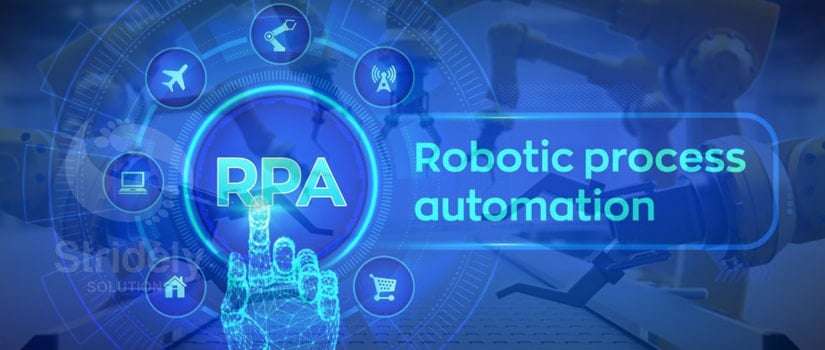Ever wondered how much does the execution of repetitive and mundane tasks cost to your company? Well, it does cost you huge.
How about replacing these and embedding automation? Like you have bots that would do all the boring days to day activities, freeing the staff and allowing them to focus on much more important stuff. This would not only reduce the total man-hours required to execute an operation but at the same time, increase the efficiency and reduce the cost.
Great, right?
This is what the Robotic Process Automation does.
What is Robotic Process Automation?
In simple terms, RPA is embedding automatic in the manufacturing industry to carry out everyday tasks more effectively. You can consider it to be a software that integrates with your line of business operations and help automate tasks which otherwise is done by a workforce, consuming time and effort.
Several manufacturing industries have already adopted this form of operation and attained a huge level of efficiency, streamlining the back-office processes.
In case, you are yet to make the decision and wondering why on earth you would automate your work in an office job, this article is just right for you.
Why Should You Implement RPA?
Before we move ahead to see how RPA benefits the manufacturing industry, we highlight the reasons that compel the need to do.
The first and the most important being the need to map the rising business requirements. It is no surprise that enterprises today are fighting to remain atop. With constantly evolving expectations of the customer, the business needs change and it is a must to adhere to the same in order to safeguard their position in the industry.
Given the existing infrastructure, it is impossible to maintain a balance between the company offerings and consumer demands. Also, mapping the industry advancements mandate leaders to upscale their business operations or simply automate.
A recent incident suggests a manufacturing industry adopted Robotic Process automation within their line of operations and while doing so, they cut down a total of 2650 hours every month. Imagine the level of efficiency and the extent of productivity achieved.
And this is just one case and one example, if implemented right, RPA can:
- Accelerate the time to market
- Eliminate the possibility of errors within the execution phase
- Enhance and optimize everyday routine tasks.
- Lower the cost of operations
- Add more agility to the business operations.
In short, embedding robotic process automation within your manufacturing industry is a win-win for all. Your staff can focus on better tasks, the production time is reduced, the efficiency increased and, in a way,, your customers are way happier. It is expected that a full-proof implementation of robotic process automation within the manufacturing industry can increase the overall productivity by 40%, not to mention the cost savings and the increment inefficiency.
Excellent right? Now that you are pretty much moved with the idea of integrating RPA, let’s move ahead to see how RPA benefits the industry. We know what it does, the question now is how?
How RPA Enhances Efficiency Of Manufacturing Industry?
Manufacturing industries have a lot to do and while doing all, they are bound to be knocked by some challenges. These reduce efficiency and Robotic Process Automation is what we do to combat the effect of the same.
Here, we outline three major challenges faced by the present-day manufacturers, followed by the solution rendered by RPA.
-
Challenge One: BOM Execution
As a manufacturer, you might be aware of what bills of material are and how does that benefit your organization, right? In simple terms, it is an ERP solution that creates a list of raw materials needed to manufacture a product. When done with manual support, the odds of committing errors is huge.
To deal with the above, manufacturers can easily put RPA to use. These bots are so designed that they can handle all of the BOM needs in real-time, eliminating the possibility of errors. This fosters the process of manufacturing products without costing the company more than needed.
-
Challenge Two: Communication Gap
Given that there are several stations and working offices of a single manufacturer, followed by loads of users, adhering and addressing each of their concerns is a time-consuming task. Further, neglecting issues faced by a consumer, you might end up losing one.
Under the influence of RPA, organizations can better track the communication between the enterprise and the customer. As so it appears, bots are trained to handle these communications, automate replies and send emails as and when required. Also, communication is shared with the concerned representative to avoid any possible conflict.
-
Challenge Three: Data Migration
Imagine the time and effort taken to migrate all of your organization data from the old system to a new one or from files to online software. Organizing, managing and feeding loads of data with manual support is no less than a nightmare.
RPA is an excellent solution for the above. They digitize the entire process and convert the data to the system automatically. The fact that they are machines, they run endlessly throughout the day, increasing the amount of work done, saving human labor. Also, the fact that everything is automated, the possibility of committing errors is next to zero.
The Final Word
Robotic Process Automation is the new normal and nearly every industry, let alone the manufacturing sector should deploy the same to enhance, optimize and improvise their end to end business operations, increasing productivity and reducing costs, at large.


